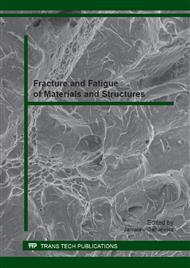[1]
R.T. Cundill, Rolling element bearings into 21st century, IMechE, Seminar, London, November, 1990.
Google Scholar
[2]
Y. Wang, M. Hadfield, The influence of ring crack location on the rolling contact fatigue failure of lubricated silicon nitride: experimental studies, Wear 243 (2000), 157-166.
DOI: 10.1016/s0043-1648(00)00435-x
Google Scholar
[3]
W. Karaszewski, The influence of oil additives on spread cracks in silicon nitride, Tribology International, vol.41, issue 9-10 (2008) 889-895.
DOI: 10.1016/j.triboint.2007.12.002
Google Scholar
[4]
Y. Wang, M. Hadfield, Failure modes of ceramic rolling elements with surface crack defects. Wear 256 (2004) 208-219.
DOI: 10.1016/s0043-1648(03)00409-5
Google Scholar
[5]
W. Karaszewski, Surface cracks of ceramic rolling elements, Acta Mechanica et Automatica, vol. 3, no.1(7) (2009) 68-70.
Google Scholar
[6]
W. Karaszewski, Badanie wpływu wybranych czynników na trwałość ceramicznych elementów łożysk tocznych (Research on the effect of selected factors on the life of ceramic rolling bearing elements), Wydawnictwo Politechniki Gdańskiej (Technical University of Gdansk Publication), Seria monografie, nr 140 (2013) 202.
Google Scholar
[7]
Y. Wang, M. Hadfield, The influence influence of ring crack location on the rolling contact fatigue failure of lubricated silicon nitride: fracture mechanics analysis, Wear 243 (2000) 167-174.
DOI: 10.1016/s0043-1648(00)00436-1
Google Scholar
[8]
W. Karaszewski, Influence of ring cracks on fatigue in silicon nitride, Tribologia, R. 35 vol. 3 (2004) 159-168
Google Scholar
[9]
W. Karaszewski, Limitation of fatigue life of ceramic couples due to surface ring cracks, Tribologia, R. 40 vol. 2 (2009) 29-38.
Google Scholar
[10]
W. Karaszewski Crack propagation in zirconia MgO-PSZ ceramic materials. Key Engineering Materials, vol. 490 (2012) 54-63.
DOI: 10.4028/www.scientific.net/kem.490.54
Google Scholar
[11]
W. Karaszewski: Numerical analysis of crack propagation in silicon nitride. Key Engineering Materials, Vol. 490 (2012) 216-225.
DOI: 10.4028/www.scientific.net/kem.490.216
Google Scholar
[12]
Information on http://www.beasy.com
Google Scholar
[13]
I. Bar-On, J.T. Beals, Fatigue 90: proceedings of 4th International Conference on Fatigue and fatigue Thresholds, vol. 2, Edgbaston, UK (1990) 793-798.
Google Scholar


